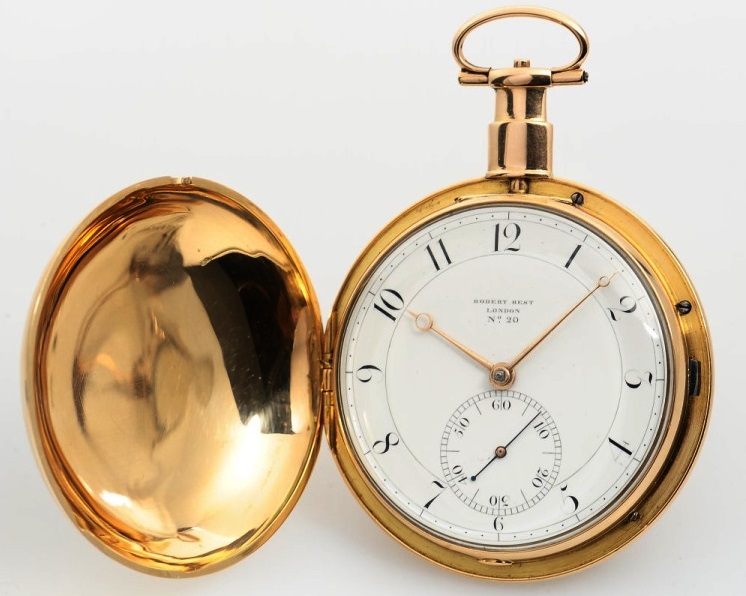Datei:Robert Best, London, Nr. 2193, circa 1790 (1).jpg
Robert_Best,_London,_Nr._2193,_circa_1790_(1).jpg (746 × 596 Pixel, Dateigröße: 107 KB, MIME-Typ: image/jpeg)
Robert Best, Royal Exchange, London, Werk Nr. 2193, Geh. Nr. 2193, 61 mm, 175 g, circa 1790

|
Alle Bildrechte liegen bei dem Auktionshaus Auktionen Dr. H. Crott. Diese Abbildung ist urheberrechtlich geschützt und steht nicht unter einer freien Lizenz. Für anderweitige Nutzungen außerhalb von Watch-Wiki ist die schriftliche Zustimmung des Urheberrechtsinhabers nötig. |
Taschenchronometer von Thomas Earnshaw, mit "Zuckerzangen"-Temperaturkompensation für Unruhspirale
Geh.: 18Kt Roségold, glatt, Gehäusemacher-Punzzeichen "IM", vorder- und rückseitiger Sprungdeckel. Ziffbl.: Email, radiale arab. Zahlen, kleine Sekunde, Nr. 20, Breguet-Goldzeiger. Werk: Vollplatinenwerk, gekörnt, vergoldet, signiert, Schlüsselaufzug, Kette/Schnecke, profilierte Pfeiler, Federchronometerhemmung nach Thomas Earnshaw, dreiarmige Stahlunruh, bimetallische "Zuckerzangen"-Temperaturkompensation für gebläute Unruhspirale, floral gravierter Unruhkloben.
A pocket chronometer by Thomas Earnshaw with "sugar tongs"- temperature compensation for balance spring Case: 18k rose gold, polished, case maker punch mark "IM", jumping lids on the front and back side. Dial: enamel, radial Arabic numerals, auxiliary seconds, No. 20, gold Breguet hands. Movm.: full plate movement, frosted, gilt, signed, keywind, chain/fusee, moulded pillars, spring detent escapement according to Thomas Earnshaw, three-arm steel balance, bimetallic "sugar tongs"- temperature compensation for blued balance spring, florally engraved balance cock.
Robert Best Robert Best trained from 1778 to 1782 with Thomas Earnshaw Snr and then worked as foreman in the workshop of renowned chronometer maker John Brockbank at 5 Cowpers Court; around 1790 Best had his own business at 4 White Lion Court, Birchin Lane. After 1798 he was located at 4 Sweetings Alley and after 1810 at 1 Windsor Place, St. Paul’s; Best was a member of the Clockmakers’ Company from 1783 until 1820. Around 1796 Best was bankrupt and emigrated to Constantinople for some time; he returned to support his master Earnshaw’s claim regarding his chronometer escapement, which was heavily contested by John Arnold’s son John Roger Arnold and Dr. Maskelyne, the resident Astronomer Royal during the Board of Longitude's enquiries in 1804. Best was, together with Joseph Watkins, Charles John Cope und William Frodsham, also in a partnership with P.P. Barraud and George Jamison for the production of Mudge chronometers. The case of the watch was probably made by James Macklin at 7 Plumtree Street, Bloomsbury; its movement closely resembles Barraud’s watch E3 /1803/218 (delivered by Earnshaw); this is the same with the movements of Earnshaw’s watch no. 30175 and other Earnshaw watches. The authors‘ assumption that this is clearly a watch produced by Thomas Enarnshaw Snr is confirmed by Earnshaw himself - in his famous pamphlet he states that many of his pocket chronometers with spring detent escapement bore the signatures of distributors and mentions, among others, Robert Best in this context. Thus our no. 2193 has an Earnshaw number and is consequently listed in the catalogue of his works published by Anthony G. Randall in "The Time Museum Catalogue of Chronometers" on page 144ff..
Dateiversionen
Klicke auf einen Zeitpunkt, um diese Version zu laden.
| Version vom | Vorschaubild | Maße | Benutzer | Kommentar | |
|---|---|---|---|---|---|
| aktuell | 13:30, 18. Apr. 2015 |  | 746 × 596 (107 KB) | Andriessen (Diskussion | Beiträge) | Robert Best, Royal Exchange, London, Werk Nr. 2193, Geh. Nr. 2193, 61 mm, 175 g, circa 1790 {{Bildrechte U|dem Auktionshaus Auktionen Dr. H. Crott}} Taschenchronometer von Thomas Earnshaw, mit "Zuckerzangen"-Temperaturkompensation für Unruhspira… |
Du kannst diese Datei nicht überschreiben.
Dateiverwendung
Die folgende Seite verwendet diese Datei:
